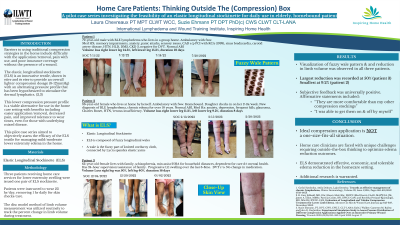Case Series/Study
(CS-044) Home Care Patients: Thinking Outside The (Compression) Box

A pilot case series investigating the feasibility of an elastic longitudinal stockinette for daily use in home bound patients. Three patients receiving home care services for lower extremity swelling were issued one pair of ELS stockinette. Patients were instructed to wear 23 hours/day, removing 1 hr daily for skin checks/care. The disc model method of limb volume measurement was utilized routinely to track percent change in limb volume during treatment. Subjective feedback was documented regarding comfort and ease of use. Reduction in limb volume was observed in all three patients; largest reduction recorded at 15.3% (patient 1) and smallest at 9.2% (patient 2). Subjective feedback was universally positive. Affirmative statements included: “more comfortable than other compression stockings”, “I was able to get them on/off myself”. Although the majority of the compression literature supports traditional treatment strategies; ideal compression application is not a one size fits all situation. Home care clinicians are often faced with unique edema management challenges, thus forced to think outside the box to optimize edema reduction outcomes. This pilot case series utilizing ELS demonstrated effective, economic and tolerable edema reduction. Additional research with an increased sample size is warranted.
Traditional short stretch compression wraps and stockings are currently viewed as the gold standard for edema management across the continuum of care.(1) Barriers to use of traditional compression strategies in the home include: difficulty with the application/removal, pain with use and poor insurance coverage without the presence of a wound. The elastic, longitudinal stockinette (ELS) is an innovative textile, shown in vitro and in vivo to provide both an overall lighter compression dosage (8-12mmHg) with an alternating pressure profile that has been hypothesized to stimulate the dermal lymphatics.(2,3) This lower compression pressure profile is a viable alternative for use in the home care setting with benefits including easier application/removal, decreased pain, and improved tolerance to wear times, even for those with underlying mixed disease. The aim of this pilot case series was to objectively assess the efficacy of the ELS textile for the management of mild/moderate lower extremity edema in the home.
Methods:
Results:
Discussion:
Trademarked Items:
References: 1. Győző Szolnoky, Attila Dobozy, Lajos Kemény, Towards an effective management of chronic lymphedema, Clinics Dermatology, Volume 32, Issue 5,2014, Pages 685-691,ISSN 0738-081X
2. R. Gary Sibbald, MD, DSc (Hons), Med, BSc, FRCPC (Med Derm), FAAD, MAPWCA, JM; James A. Elliot, MMSc; Patricia Coutts, RN, IIWCC-CAN; and Reneeka Persaud-KJaimangal, MD, MScCH, IIWCC-CAN, Evaluation of Longitudinal and Tubular Compression Treatment for Lower Limb Edema, Advances in Skin & Wound Care Journal, pp 643-649, December 2000
3. Suzie Ehmann, PT, DPT, CWS, CWLT, CLT-LANA; Kyle J. Walker; Cameron M. Bailey; and John D. DesJardins, Experimental Simulation Study to Assess Pressure Distribution of Different Compression Applications Applied Over an Innovative Primary Wound Dressing, Wounds 2020;32(12):353–363. Epub 2020 August 17

.png)
